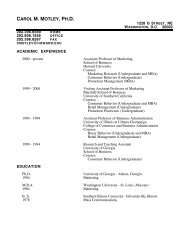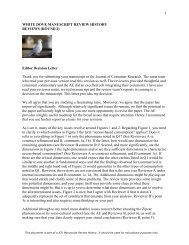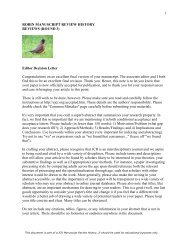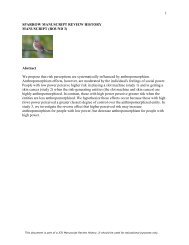Why Happiness Helps You See the Big Picture - Journal of ...
Why Happiness Helps You See the Big Picture - Journal of ...
Why Happiness Helps You See the Big Picture - Journal of ...
Create successful ePaper yourself
Turn your PDF publications into a flip-book with our unique Google optimized e-Paper software.
Copyright <strong>Journal</strong> <strong>of</strong> Consumer Research 2008.<br />
Preprint (not formatted or copyedited).<br />
Do not quote or cite without permission.<br />
2<br />
Ever consider that <strong>the</strong> pictures <strong>of</strong> your children smiling on your refrigerator door<br />
do more than just make you feel good—that <strong>the</strong>y possibly help you make better and<br />
healthier food choices Might <strong>the</strong> funnies in <strong>the</strong> newspaper do more than just make you<br />
laugh; do <strong>the</strong>y actually help you get a broader perspective <strong>of</strong> <strong>the</strong> daily news And feeling<br />
happy (vs. unhappy) would your food choices or perspective on world issues be any<br />
different if you were focused on why health or news is important to your future instead <strong>of</strong><br />
how you should improve your health or gain information in <strong>the</strong> moment<br />
On <strong>the</strong> one hand, existing research has argued that a positive mood plays an<br />
adaptive role in human functioning (Aspinwall 1998; Isen and Labroo 2003;<br />
Raghunathan and Trope 2000). It broadens attention and allows people to focus on future<br />
opportunities (Fishbach and Labroo 2007). Therefore, with respect to <strong>the</strong> foregoing<br />
example, a positive mood will signal that long-term goals are an opportunity not to be<br />
disengaged from and result in healthy food choices and a broader perspective on <strong>the</strong><br />
news. However, o<strong>the</strong>r research has argued that a positive (vs. negative) mood signals that<br />
all is currently well (Andrade 2005; Pham 1998; Schwarz and Clore 1983). Therefore,<br />
with respect to <strong>the</strong> forgoing examples, this latter stream <strong>of</strong> research would make <strong>the</strong><br />
opposite prediction; that is, a positive mood will signal that in <strong>the</strong> moment regulation is<br />
not needed, and <strong>the</strong> person will readily indulge in rich foods and not bo<strong>the</strong>r about today’s<br />
news.<br />
Integrating <strong>the</strong>se findings and building on <strong>the</strong> mood-as-information perspective<br />
(Schwarz and Clore 1983), we argue that by signaling that a situation is benign, a positive<br />
mood allows people to distance <strong>the</strong>mselves psychologically from <strong>the</strong> situation.<br />
Psychological distancing results in taking a broader perspective, or seeing <strong>the</strong> big picture<br />
(Bar-Anan, Liberman, and Trope 2006; Liberman, Sagristano, and Trope 2002; Trope<br />
and Liberman 2003; Trope, Liberman, and Wakslak 2007); thus, a positive mood<br />
increases abstract construal or high-level thinking. In contrast, by signaling not only<br />
danger but also its imminence, a negative mood leads people to take a more proximal<br />
perspective, which results in concrete low-level construal. A consequence <strong>of</strong> seeing <strong>the</strong><br />
big picture is that compared with people in a negative mood, those in a positive mood not<br />
only adopt abstract, future goals and work harder toward attaining <strong>the</strong>m, but also reduce<br />
<strong>the</strong>ir efforts when goals are proximal or concrete.<br />
In what follows, we present a construal account <strong>of</strong> mood and <strong>the</strong>n five<br />
experiments. We conclude with a discussion <strong>of</strong> how <strong>the</strong> findings provide a <strong>the</strong>oretically<br />
new interpretation <strong>of</strong> mood effects.<br />
THEORETICAL BACKGROUND<br />
It is well accepted that a positive mood signals that <strong>the</strong> immediate environment is<br />
benign and that a negative mood signals imminent danger (Schwarz and Clore 1983). As<br />
a consequence, happy people reduce <strong>the</strong> amount <strong>of</strong> attention to and effort toward any task<br />
in which <strong>the</strong>y are currently engaged, whereas unhappy people become more cautious and<br />
vigilant with regard to such tasks (Bless et al. 1990). This view is also compatible with<br />
research showing that a positive mood signals to <strong>the</strong> motivational system <strong>the</strong> attainment<br />
<strong>of</strong> sufficient progress toward <strong>the</strong> accomplishment <strong>of</strong> current goals, indicating that effort<br />
can now be conserved. In contrast, a negative mood signals a large discrepancy between a









